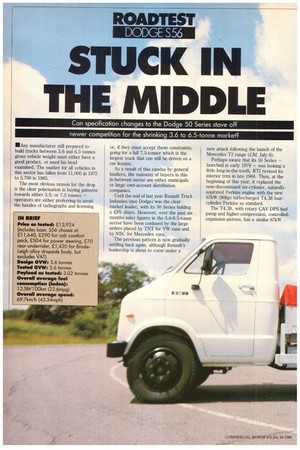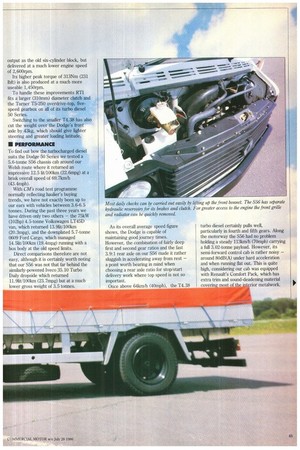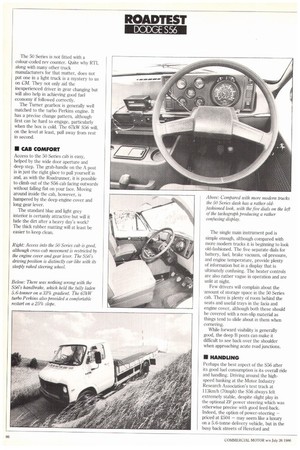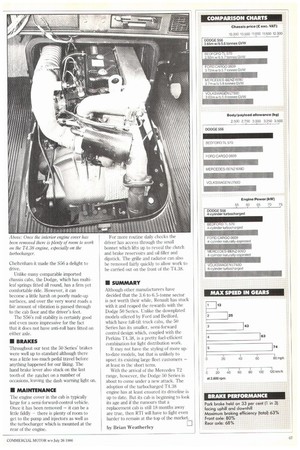STUCK IN THE MIDDLE
Page 66

Page 67

Page 68

Page 69

If you've noticed an error in this article please click here to report it so we can fix it.
Can specification changes to the Dodge 50 Series stave off newer competition for the shrinking 3.6 to 6.5-tonne market?
/Any manufacturer still prepared to build trucks between 3.6 and 6.5 tonnes gross vehicle weight must either have a good product, or need his head examined. The market for all vehicles in this sector has fallen from 11,000 in 1975 to 5,700 in 1985.
The most obvious reason for the drop is the clear polarisation in buying patterns towards either 3.5; or 7.5 tonnes — operators are either preferring to avoid the hassles of tachographs and licensing or, if they must accept these constraints, going for a full 7.5-tonner which is the largest truck that can still be driven on a car licence.
As a result of this exodus by general hauliers, the mainstay of buyers in this in-between sector are either municipals or large own-account distribution companies.
Until the end of last year Renault Truck Industies (nee Dodge) was the clear market leader, with its 50 Series holding a 43% share. However, over the past six months sales figures in the 3.6-6.5-tonne sector have been confused by the large orders placed by TNT for VW vans and by NBC for Mercedes vans.
The previous pattern is now gradually settling back again, although Renault's leadership is about to come under a new attack following the launch of the Mercedes T2 range (CM, July 6).
Perhaps aware that its 50 Series — launched in early 1979 — was looking a little long-in-the-tooth, RTI revised its interior trim in late 1984. Then, at the beginning of this year, it replaced the now-discontinued six-cylinder, naturallyaspirated Perkins engine with the new 67kW (90hp) turbocharged T4.38 fourcylinder Perkins as standard.
The 14.38, with rotary CAV DPS fuel pump and higher-compression, controlledexpansion pistons, has a similar 67kW output as the old six-cylinder block, but delivered at a much lower engine speed of 2,600rpm.
Its higher peak torque of 313Nm (231 lbft) is also produced at a much more useable 1,450rpm_ To handle these improvements RT1 fits a larger (310mm) diameter clutch and the Turner 15-250 overdrive-top, fivespeed gearbox on all of its turbo diesel 50 Series.
Switching to the smaller T4.38 has also cut the weight over the Dodge's front axle by 43kg, which should give lighter steering and greater loading latitude.
• PERFORMANCE To find out how the turbocharged diesel suits the Dodge 50 Series we tested a 5.6-tonne S56 chassis cab around our Welsh route where it returned an impressive 12.5 lit/100km (22.6mpg) at a brisk overall speed of 69.7km/h (43.4mph).
With CM'S road test programme normally reflecting haulier's buying trends, we have not exactly been up to our ears with vehicles between 3.6-6.5 tonnes. During the past three years we have driven only two others — the 75kW (102hp) 4.5-tonne Volkswagen LT45D van, which returned 13.91iti1001un (20.3mpg), and the downplated 5.7-tonne 0609 Ford Cargo, which managed 14.51it/100km (19.4mpg) running with a box body at the old speed limits.
Direct comparisons therefore are not easy, although it is certainly worth noting that our S56 was not that far behind the similarly-powered Iveco 35.10 Turbo Daily dropside which returned 11.91it/1001un (23.7mpg) but at a much lower gross weight of 3.5 tonnes. As its overall average speed figure shows, the Dodge is capable of maintaining good journey times.
However, the combination of fairly deep first and second gear ratios and the fast 3.9:1 rear axle on our S56 made it rather sluggish in accelerating away from rest — a point worth bearing in mind when choosing a rear axle ratio for stop/start delivery work where top speed is not so important.
Once above 64Iun/h (40mph), the T4.38 turbo diesel certainly pulls well, particularly in fourth and fifth gears. Along the motorway the S56 had no problem holding a steady 113km/h (70mph) carrying a full 3.02-tonne payload. However, its semi-forward control cab is rather noisy — around 80dB(A) under hard acceleration and when running flat out. This is quite high, considering our cab was equipped with Renault's Comfort Pack, which has extra trim and sound-deadening material coverin most of the nor metalwork. The 50 Series is not fitted with a colour-coded rev counter. Quite why RT1, along with many other truck manufacturers for that matter, does not put one in a light truck is a mystery to us on CM. They not only aid the inexperienced driver in gear changing but will also help in achieving good fuel economy if followed correctly.
The Turner gearbox is generally well matched to the turbo Perkins engine. It has a precise change pattern, although first can be hard to engage, particularly when the box is cold. The 67kW S56 will, on the level at least, pull away from rest in second.
• CAB COMFORT
Access to the 50 Series cab is easy, helped by the wide door aperture and deep step. The grab-handle on the A post is in just the right place to pull yourself in and, as with the Roadrunner, it is possible to climb out of the S56 cab facing outwards without falling flat on your face. Moving around inside the cab, however, is hampered by the deep engine cover and long gear lever.
The standard blue and light grey interior is certainly attractive but will it hide the dirt after a heavy day's work? The thick rubber matting will at least be easier to keep clean. The single main instrument pod is simple enough, although compared with more modern trucks it is beginning to look old-fashioned. The five separate dials for battery, fuel, brake vacuum, oil pressure, and engine temperature, provide plenty of information but in a display that is ultimately confusing. The heater controls are also rather vague in operation and are unlit at night.
Few drivers will complain about the 'amount of storage space in the 50 Series cab. There is plenty of room behind the seats and useful trays in the facia and engine cover, although both these should be covered with a non-slip material as things tend to slide about in them when cornering.
While forward visibility is generally good, the deep B posts can make it difficult to see back over the shoulder when approaching acute road junctions.
• HANDLING
Perhaps the best aspect of the S56 after its good fuel consumption is its overall ride and handling. Driving around the highspeed banking at the Motor Industry Research Association's test track at 113km/h (70mph) the S56 always felt extremely stable, despite slight play in the optional ZF power steering which was otherwise precise with good feed-back. Indeed, the option of power-steering — priced at £504 — may seem like a luxury on a 5.6-tonne delivery vehicle, but in the busy back streets of Hereford and Cheltenham it made the S56 a delight to drive.
Unlike many comparable imported chassis cabs, the Dodge, which has multileaf springs fitted all round, has a firm yet comfortable ride. However, it can become a little harsh on poorly made-up surfaces, and over the very worst roads a fair amount of vibration is passed through to the cab floor and the driver's feet.
The S56's roll stability is certainly good and even more impressive for the fact that it does not have anti-roll bars fitted on either axle.
• BRAKES
Throughout our test the 50 Series' brakes were well up to standard although there was a little too much pedal travel before anything happened for our liking. The hand brake lever also stuck on the last tooth of the ratchet on a number of occasions, leaving the dash warning light on.
• MAINTENANCE
The engine cover in the cab is typically large for a semi-forward-control vehicle. Once it has been removed — it can be a little fiddly — there is plenty of room to get to the pump and injectors as well as the turbocharger which is mounted at the rear of the engine. For more routine daily checks the driver has access through the small bonnet which lifts up to reveal the clutch and brake reservoirs and oil filler and dipstick. The grille and radiator can also be removed fairly quickly to allow work to be carried out on the front of the T4.38.
• SUMMARY
Although other manufacturers have decided that the 3.6 to 6.5-tonne sector is not worth their while, Renault has stuck with it and reaped the rewards with the Dodge 50 Series. Unlike the downplated models offered by Ford and Bedford, which have full-tilt truck cabs, the 50 Series has its smaller, semi-forward control design which, coupled with the Perkins T4.38, is a pretty fuel-efficient combination for light distribution work.
It may not have the styling of more upto-date models, but that is unlikely to upset its existing large fleet customers — at least in the short term.
With the arrival of the Mercedes T2 range, however, the Dodge 50 Series is about to come under a new attack. The adoption of the turbocharged T4.38 engine has at least ensured its drivefine is up to date. But its cab is beginning to look its age and if the rumours that a replacement cab is still 18 months away are true, then RTI will have to fight even harder to remain at the top of the market.
by Brian Weatherley




















































































































